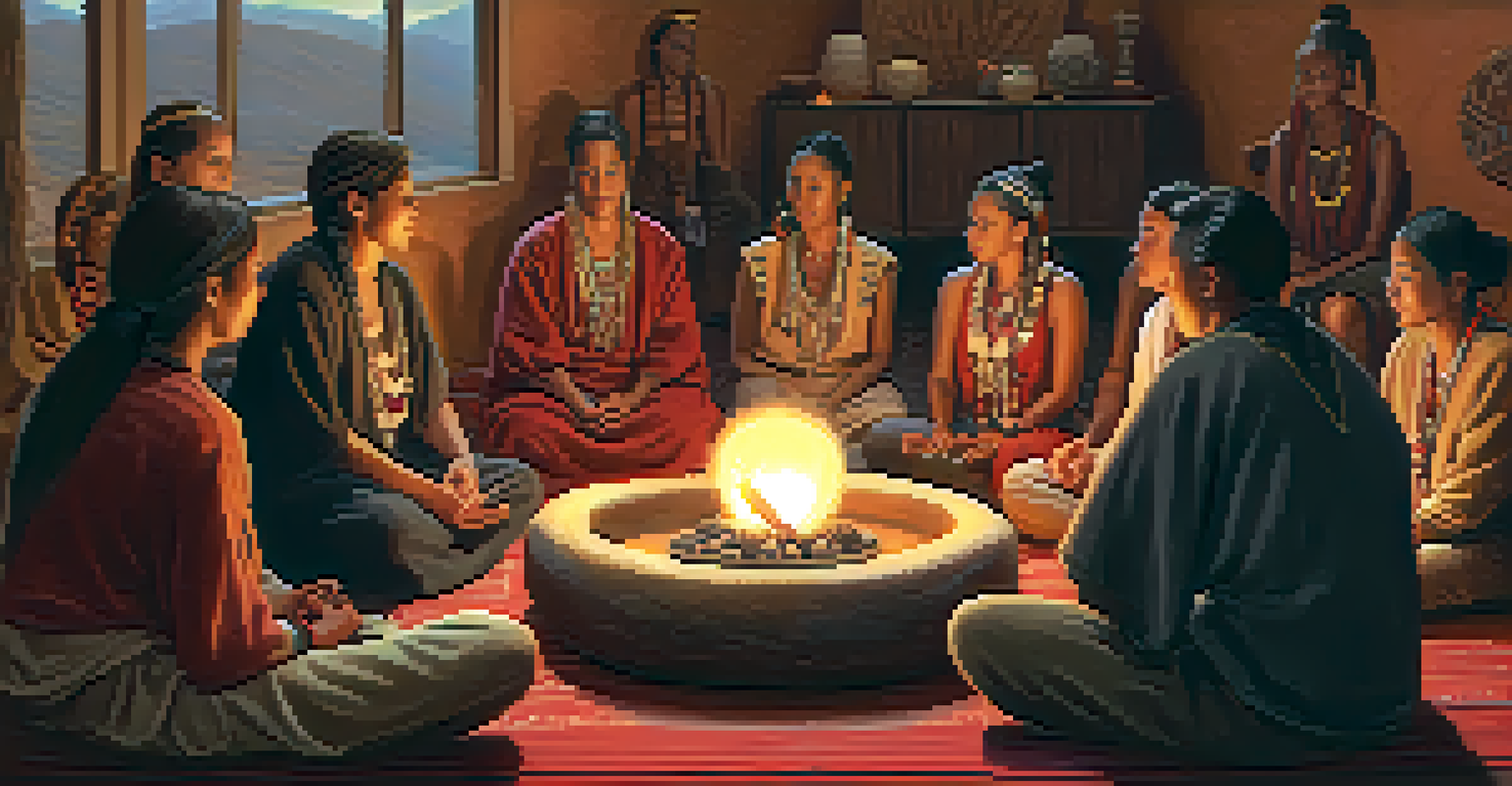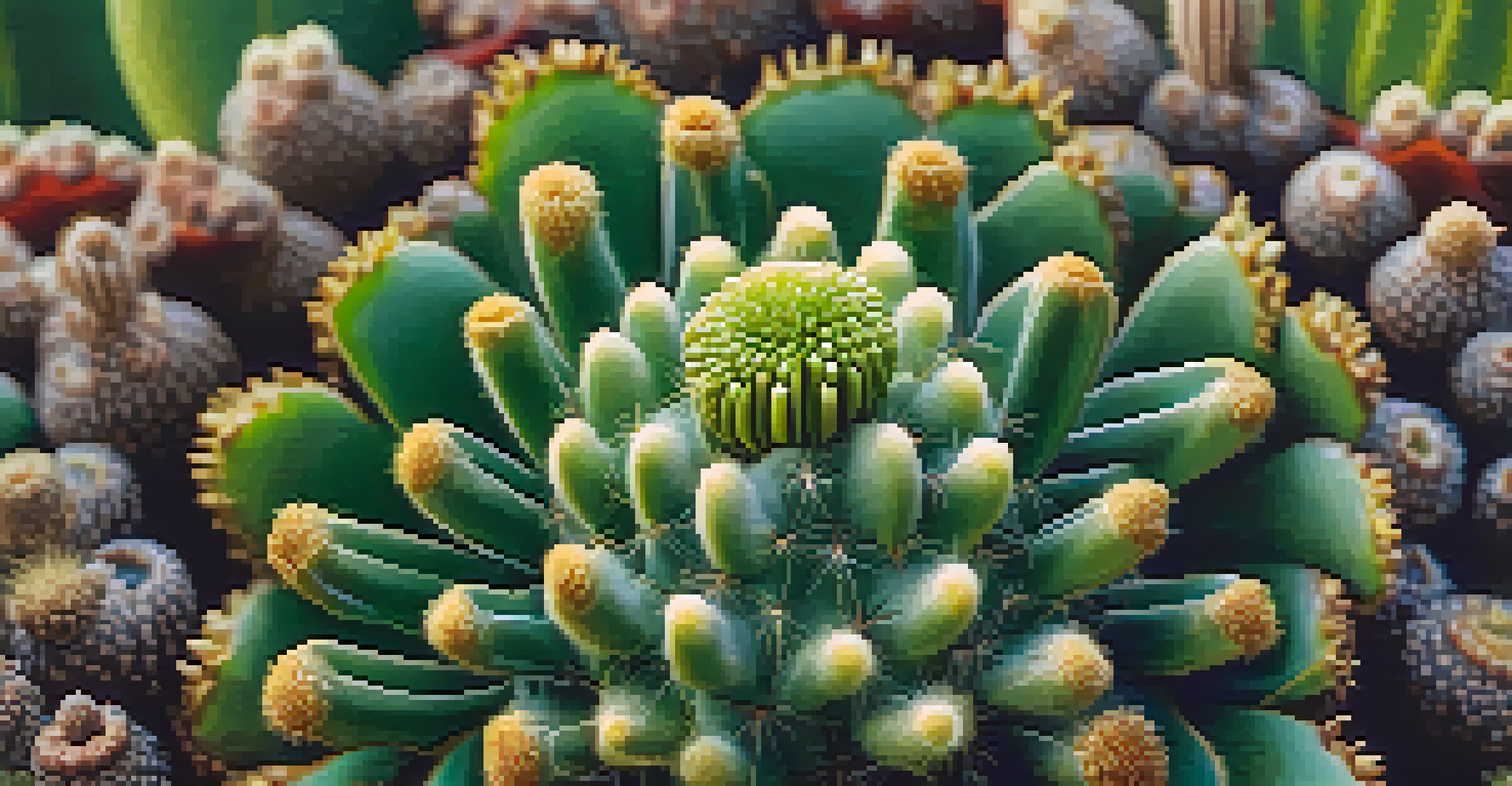Rituals Involving Peyote and Their Ancestral Connections

Understanding Peyote: A Sacred Cactus
Peyote, a small cactus native to the southwestern United States and Mexico, is known for its psychoactive properties, primarily due to the compound mescaline. For many Indigenous peoples, this cactus is more than just a plant; it represents a bridge to the spiritual realm. Its use in rituals dates back thousands of years, making it a significant aspect of cultural heritage.
Peyote is not just a plant; it is a bridge to the spiritual realm, connecting us to our ancestors and traditions.
The vibrant green of the Peyote cactus and its distinctive button-like formations have become symbols of spiritual journeys. In many communities, Peyote is seen as a living entity, deserving of respect and reverence. This perspective emphasizes the importance of honoring the plant and its role in their traditions.
Incorporating Peyote into spiritual practices allows individuals to connect deeply with their ancestry. These rituals often involve prayer, song, and communal gatherings that strengthen bonds within the community. As we explore these ceremonies, we gain insight into their profound significance.
Historical Context of Peyote Use
The use of Peyote has roots that extend into ancient Mesoamerican cultures, where it was employed in religious ceremonies and healing practices. Evidence suggests that this sacred plant was integral to the spiritual lives of various Indigenous groups long before European contact. These early practices laid the groundwork for the rituals we see today.

Throughout history, Peyote's role has evolved, particularly with the emergence of the Native American Church in the early 20th century. This organization aimed to protect the rights of Indigenous peoples to practice their spiritual traditions, including Peyote rituals. The establishment of such a church has helped preserve these practices amidst external pressures.
Peyote's Spiritual Significance
Peyote serves as a sacred bridge to the spiritual realm for Indigenous peoples, deeply rooted in their cultural heritage and rituals.
Today, the history of Peyote use serves as a testament to resilience and cultural preservation. Understanding this context helps us appreciate the significance of these rituals, highlighting how they have adapted while remaining rooted in tradition.
Key Rituals Involving Peyote
Peyote rituals vary widely among different tribes, but they typically involve a ceremony known as the 'Peyote meeting'. This gathering often includes singing, drumming, and the sharing of prayers, creating a sacred space for participants. The collective experience fosters a sense of unity and shared purpose.
Cultural rituals are the heartbeat of our communities, reminding us of who we are and where we come from.
During these ceremonies, participants ingest Peyote to induce altered states of consciousness, facilitating spiritual visions and deeper introspection. This process is often guided by a leader or shaman who helps navigate the experience, ensuring that it remains respectful and meaningful. The use of Peyote is seen as a means of connecting with ancestors and the divine.
The rituals often culminate in the sharing of insights and experiences, reinforcing community bonds. This collective sharing not only helps individuals process their experiences but also enriches the community's understanding of their shared spirituality.
The Role of Community in Peyote Rituals
Community plays a vital role in Peyote rituals, as these gatherings are not just individual experiences but collective journeys. Participants often come together to support one another, fostering a sense of belonging and shared identity. This communal aspect is one of the most powerful elements of the rituals.
Through these gatherings, individuals are reminded of their connection to both their ancestors and fellow community members. The act of sharing stories and experiences creates a tapestry of cultural memory that reinforces the values and teachings of their forebears. This is essential for the continuation of their traditions.
Community-Centric Rituals
Peyote rituals foster a sense of belonging and shared identity among participants, emphasizing the importance of community in spiritual journeys.
Moreover, the communal nature of these rituals helps combat feelings of isolation and disconnection that can arise in modern society. By coming together, participants find strength and support, enriching their spiritual journeys through shared experiences.
Cultural Significance of Peyote Rituals
The cultural significance of Peyote rituals extends beyond individual experiences; they serve as a vital link to cultural identity and heritage. These ceremonies are often seen as a way to reclaim and revitalize Indigenous traditions in the face of historical oppression. They foster a sense of pride and continuity within communities.
Peyote rituals also play a crucial role in healing, both on a personal and communal level. Participants often report profound emotional and psychological benefits, helping to address traumas and foster resilience. This healing aspect is deeply intertwined with their cultural narratives.
As cultural symbols, Peyote rituals remind participants of their roots and responsibilities to future generations. By engaging in these practices, communities reinforce their commitment to preserving their unique identities and passing down their traditions.
Legal and Ethical Considerations Surrounding Peyote
The legal landscape surrounding Peyote is complex and varies by country. In the United States, the Religious Freedom Restoration Act allows certain Indigenous groups to use Peyote for religious purposes. However, outside of these specific contexts, its use can be restricted, leading to ongoing debates about access and rights.
Ethically, there are concerns about the commercialization of Peyote and the potential exploitation of Indigenous cultures. As interest in Peyote grows among non-Indigenous peoples, it raises questions about cultural appropriation and respect for the traditions that have safeguarded this sacred plant for generations.
Legal and Ethical Challenges
The complex legal landscape and ethical concerns surrounding Peyote highlight the need for respect and advocacy for Indigenous practices.
Navigating these legal and ethical considerations is essential for ensuring that Peyote rituals remain authentic and respectful. Advocating for the rights of Indigenous communities and promoting awareness of their traditions is crucial in preserving the integrity of these sacred practices.
Modern Adaptations of Peyote Rituals
As society evolves, so too do the rituals surrounding Peyote. Many Indigenous communities are finding ways to adapt their practices to contemporary contexts while remaining true to their core values. These adaptations often involve incorporating modern elements that resonate with younger generations, ensuring the continuation of traditions.
For instance, some ceremonies may now include digital components, such as livestreaming events to engage a wider audience. This has opened up opportunities for education and cultural exchange, allowing more people to learn about the significance of Peyote without appropriating its use.

However, it's essential that these adaptations are approached with care and respect. By maintaining a focus on cultural integrity, communities can ensure that their rituals evolve without losing their deep-rooted significance.